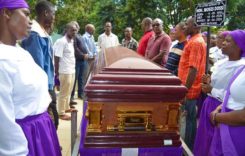That Malawi’s population is growing at an alarming rate is naked truth. The country’s population has more than trebled in the past 20 years.
That has put unprecedented pressure on social service delivery and the environment.
With this population boom, the arable land size has also been dwindling. The result is that many households are often hit by hunger every year.
As if this is no impediment enough, child marriage cases keep sky-diving, and the result is a prolonged child bearing period among women.
Mchinji District, which is one of the country’s border districts, is rated as one of the places with highest child marriage cases.
According to United Nation’s Population Fund (UNPF) data, which Mchinji District Social Welfare Office is in possession of, the district has the second highest record of teenage and child marriage cases in Malawi after Ntchisi.
Tidziwenji (not real name) is a 16 year old girl in the area of Traditional Authority Nyoka in the district. She has just given birth to a baby girl.
She was due to sit for her Primary School Leaving Certificate Examinations (PSLCE) this year, but has pulled out of school to nurse her pregnancy.
Her baby is just two months old. Tidziwenji’s case is just a page of teenage and child marriage cases that would probably fill up a book.
While organisations and other stakeholders which work to promote girl child welfare might feel overwhelmed with the teenage and child marriage scale, the young girls have their own tales to share.
The reasons they give might not make sense. Ndaziona (not real name) is yet another girl in the same district. But unlike Tidziwenji, she has never become pregnant.

The 17-year-old form-two girl fled her home because of what she terms as lack of parental care.
She is one of the ten children her parents gave birth to. She says marriage was just the relief she found, unlike staying in a small hut that forced them to struggle in almost anything.
To her, what compounded matters was lack of school fees. She was sent out of school for not paying tuition fees.
“I left school and got married with my boyfriend because my parents failed to pay my school fees, so I just left home and followed my boyfriend to his house,” she says.
Tidziwenji and Ndaziona’s stories are among scores of other stories of teenage pregnancies and child marriages Mchinji District has recorded recently.
The data available with stakeholders working in the field of child protection in the district are appalling.
For example, the Social Welfare Office says over 538 girls got pregnant between March and July this year (2020) while over 418 others went into marriages.
The District Education Office has also recorded over 79 teenage pregnancies.
The data also shows that 19 primary school boys have entered marriages whilst over 87 primary school girls also got married.
Furthermore, the data recorded by the District Health System shows that from March to June, over 411 teenage girls sought antenatal services with health centres in the district.
The figures are too high compared to the same period last year (2019), according Mchinji District Coordinator for Youth Friendly Health Services, Agness Jalafi.
She feels the trend may be attributed to the COVID-19 pandemic.
“Since March after school closure, our health facilities have been recording high numbers of teenage girls seeking antenatal services.
“From March to May, we recorded about 368 cases, and by June, we had recorded over 411 cases,” she explains.
“The trend may explain why we have low youth uptake of contraceptive methods which currently is below 20 per cent,” she adds.
Jalafi says there is need for more efforts to encourage the youth to access youth-friendly health services of which youth- friendly contraceptive methods are part.
She says such efforts can reverse the current trend.
But Assistant Social Welfare Officer in the district, Hanna Mangani, believes the fight against teenage pregnancies and child marriages will be in vain if parents do not take their responsibilities.
She says as a Social Welfare Office, they meet numerous challenges in course of their duties to track child marriage cases.
“As Social Welfare Office, we work hand in hand with the police in tracking down such the cases.
“But one of the impeding issues we meet is that parents often shield the cases by changing children’s ages, which becomes a challenge to succeed with the case in the court of law,” she explains.
James Mauzauza is a Community Service Officer at Mchinji Magistrate Court. He believes that the problem lies with the cultural setup in communities.
He proposes that community structures must be sensitised on the available legislation against early or child marriages.
“Though we have good laws in place, communities have their own benchmarks where they look at teenage pregnancies and child marriages as normal.
“We have the Marriage, Divorce and Family Relations Law which is supposed to take its course on such matters, but our courts hardly receive such cases,” he says.
Community Initiative for Social Empowerment (CISE) has been working in the district for a couple of years now.
The organisation has been promoting girl-child education, part of which has been fighting child marriages.
According to CISE’s Executive Director, Margaret Sapezeka, despite the various interventions implemented by the organisation to reverse the trend, results of the efforts have been too negligible.
“We have been promoting girl-child education where we have facilitated Go-back-to school initiatives with community structures.
“However, that has not worked much since we did not include an economic empowerment aspect crucial to the fight since most girls cite poverty as the main driver of the vices,” she says.
Responding to the need, CISE partnered with Journalists Association against AIDS (JOURNAIDS) in a project ‘Enhancing Accountability in Ending Early or Forced Marriages in Mchinji, courtesy of Grand Challenges Canada.
In the project, CISE and JOURNAIDS are giving out soft loans to teen mothers through girls clubs called Girls Action Groups (GAG).
So far, the organisations have rolled out the first phase of the loan facility to the tune of K1 million.
“We feel that this revolving loan that we have launched here in Mchinji will help teen mothers economically and make independent decisions,” said JOURNAIDS Programs Manager, Dingani Mithi during the project launch.
He said the facility would also help the teen mothers to resist temptations of entering marriages, a trend which has been rampant in Mchinji.
A 20-year-old Lonely Kaima from Chibwana in T.A. Mlonyeni is one of the beneficiaries in the first phase of the loan.
Kaima was forced to quit school and become a bread winner by her parents. She then went to Lilongwe to work as a housemaid where she became pregnant. Her child is about three years now.
“I have been a victim of poverty. I was coerced into doing things that made me become a mother because of family poverty.
“But this loan will help me start up a good business to sustain my life.
“I have a business plan which requires MK 100 000. I intend to use the same to start a cotton wrapper business which will involve travelling between Malawi and Zambia,” she says.
In the project, loans will be given to young mothers who are also change agents, those who mentor and inspire other teen age girls.
The loan will be administered by Mchinji Civil Service SACCO at a 3.6 per cent interest rate.
With more of such initiatives, perhaps young girls like Ndaziona of T.A. Nyoka in the district may not be forced into early marriages due to poverty if the initiatives are scaled up.










